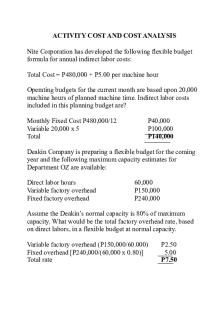Cost Minimization and the PDF

| Title | Cost Minimization and the |
|---|---|
| Course | Managerial Finance II |
| Institution | College of Staten Island CUNY |
| Pages | 4 |
| File Size | 117.6 KB |
| File Type | |
| Total Downloads | 96 |
| Total Views | 136 |
Summary
Cost Minimization and the
Cost-Minimizing Input Rule
...
Description
Cost Minimization and the Cost-Minimizing Input Rule •
Cost minimization –
•
Producing at the lowest possible cost.
Cost-minimizing input rule –
Produce at a given level of output where the marginal product per dollar spent is equal for all input:
MP L MP K = w r –
Equivalently, a firm should employ inputs such that the marginal rate of technical substitution equals the ratio of input prices:
MP L w = MP K r Optimal Input Substitution •
To minimize the cost of producing a given level of output, the firm should use less of an input and more of other inputs when that input’s price rises.
The Cost Function
•
Mathematical relationship that relates cost to the cost-minimizing output associated with an isoquant.
•
Short-run costs
•
–
Fixed costs ( FC ): do not change with changes in output; include the costs of fixed inputs used in production
–
Sunk costs
–
Variable costs [ VC ( Q ) ]: costs that change with changes in outputs; include the costs of inputs that vary with output
–
Total costs:
TC ( Q )= FC +VC ( Q )
Long-run costs –
All costs are variable
–
No fixed costs
Average and Marginal Costs
•
•
Average costs
AFC =
FC Q
–
Average fixed cost:
–
Average variable costs: AVC=
–
Average total cost:
ATC=
VC ( Q ) Q
C (Q ) Q
Marginal cost (MC) –
The (incremental) cost of producing an additional unit of output.
MC=
–
∆C ∆Q
Fixed and Sunk Costs
•
Fixed costs –
•
Sunk cost –
•
Cost that does not change with output.
Cost that is forever lost after it has been paid.
Irrelevance of Sunk Costs –
A decision maker should ignore sunk costs to maximize profits or minimize loses.
Algebraic Forms of Cost Functions •
The cubic cost function: costs are a cubic function of output; provides a reasonable approximation to virtually any cost function. C(Q) – F + aQ + bQ2 + cQ3 where a, b, c, and f are constants and f represents fixed costs
•
Marginal cost function is: MC(Q) = a + 2bQ + 3cQ2
Long-Run Costs •
In the long run, all costs are variable since a manager is free to adjust levels of all inputs.
•
Long-run average cost curve –
A curve that defines the minimum average cost of producing alternative levels of output allowing for optimal selection of both fixed and variable factors of production.
Economies of Scale
•
Economies of scale –
•
Diseconomies of scale –
•
Declining portion of the long-run average cost curve as output increase.
Rising portion of the long-run average cost curve as output increases.
Constant returns to scale –
Portion of the long-run average cost curve that remains constant as output increases.
Multiple-Output Cost Function
•
Economies of scope –
Exist when the total cost of producing Q 1 and Q 2 together is less than the total cost of producing each of the type of output separately.
C ( Q1 , 0 ) +C ( 0,Q 2 ) >C ( Q 1 , Q2 ) •
Cost complementarity –
Exist when the marginal cost of producing one type of output decreases when the output of another good is increased.
∆ MC 1 ( Q 1 ,Q2) ∆ Q2
0, there are no cost complementarities
-
Exhibits economies of scope whenever f -
aQ 1Q 2 > 0...
Similar Free PDFs

Cost Minimization and the
- 4 Pages

Activity COST AND COST Analysis
- 5 Pages

THE COST OF CAPITAL
- 15 Pages

More on Costs - Cost and cost
- 10 Pages

Cost Behavior and Cost Volume Profit
- 18 Pages

Cost control and reduction
- 15 Pages

Research and development cost
- 4 Pages

Joint Cost and Allocation
- 29 Pages
Popular Institutions
- Tinajero National High School - Annex
- Politeknik Caltex Riau
- Yokohama City University
- SGT University
- University of Al-Qadisiyah
- Divine Word College of Vigan
- Techniek College Rotterdam
- Universidade de Santiago
- Universiti Teknologi MARA Cawangan Johor Kampus Pasir Gudang
- Poltekkes Kemenkes Yogyakarta
- Baguio City National High School
- Colegio san marcos
- preparatoria uno
- Centro de Bachillerato Tecnológico Industrial y de Servicios No. 107
- Dalian Maritime University
- Quang Trung Secondary School
- Colegio Tecnológico en Informática
- Corporación Regional de Educación Superior
- Grupo CEDVA
- Dar Al Uloom University
- Centro de Estudios Preuniversitarios de la Universidad Nacional de Ingeniería
- 上智大学
- Aakash International School, Nuna Majara
- San Felipe Neri Catholic School
- Kang Chiao International School - New Taipei City
- Misamis Occidental National High School
- Institución Educativa Escuela Normal Juan Ladrilleros
- Kolehiyo ng Pantukan
- Batanes State College
- Instituto Continental
- Sekolah Menengah Kejuruan Kesehatan Kaltara (Tarakan)
- Colegio de La Inmaculada Concepcion - Cebu







